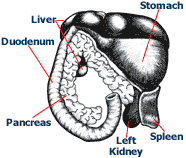On physical exam Channey was very quiet, dehydrated, had a mild fever and was painful on palpation of her abdomen. My immediate thought was that Channy’s condition was caused by pancreatitis, a fairly common diagnosis or suspected cause of vomiting and diarrhea that many people do not know much about.
Pancreatitis is an inflammation of the pancreas, a gland that lives in close contact with the stomach, liver and small and large intestines. Its major function is to secrete enzymes that help digest nutrients in the small intestine.

\Pancreatitis occurs when a breakdown causes the digestive enzymes to come into contact with the pancreatic tissue. This results in a large amount of inflammation that extends to the surrounding organs and, in severe cases, through the entire body. The most severe cases of acute pancreatitis can result in death, although this is uncommon.
 We are not sure what causes pancreatitis, but there are many suspected causes, with pet obesity and ingesting a very fatty meal being at the top of the list.
We are not sure what causes pancreatitis, but there are many suspected causes, with pet obesity and ingesting a very fatty meal being at the top of the list.My first step was to order x-rays, to find out if we could see what was causing the abdominal pain. Despite Channey’s recent steak-bone snack, I wasn’t expecting to see any bone fragments remaining, as these are usually digested very quickly. Still, I wanted to rule out any other abnormalities and make sure Channey’s small intestines had not formed a pattern consistent with obstruction. The x-rays were unremarkable which made me even more suspicious of pancreatitis.
Next, I submitted bloodwork and admitted Channey for supportive care. While I waited for Friendship’s lab to run her bloodwork, I checked a cPL snap test that specifically checks for one of the enzymes produced by the pancreas. Channey’s test was positive, confirming my diagnosis of pancreatitis. (Interestingly, this test is often negative, even in cases when I believe the dog still has pancreatitis. Yet another example of how important it is to look at how the patient is doing rather than rely solely on testing.)
I checked Channey’s bloodwork to assess the severity of her condition. She had a high white cell count consistent with inflammation and a high red cell count along with mild electrolyte abnormalities indicating she was most likely dehydrated. Fortunately, she did not have any elevations in her liver values, which can be another common finding with pancreatitis.

There is no specific treatment for pancreatitis - instead we try to alleviate the symptoms and make the patient more comfortable. We started Channey on intravenous fluid therapy to re-hydrate her and antibiotics to help with the diarrhea. Pancreatitis itself is not infectious but severe diarrhea can lead to secondary bacterial infections. To help keep her comfortable, we gave her pain medication along with anti-nausea medications. She was not offered food for twenty-four hours to allow her gastrointestinal tract time to rest and the inflammation to decrease.
Channey was in the hospital for about two and a half days before she began to improve. She started eating the small amounts of bland diet we offered her and was able to keep it down. By the fourth day we had transitioned her to oral medications, she was eating well without vomiting and appeared one hundred percent more comfortable. She went home with suggestions for weight loss and strict instructions to avoid any fatty foods.








No comments:
Post a Comment